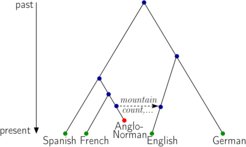Modelling horizontal transfer of linguistic features

Since the evolutionary relationships among languages can be seen analogously to the genealogical relationships of different species, phylogenetic models and methods developed originally for biological evolution are increasingly being applied to the reconstruction of past dynamics of language evolution. Namely, approaches utilizing Bayesian inference have become popular techniques to generate binary-branching trees upon linguistic material, such as lexical data. For several language families, these approaches have been utilized to estimate when languages diverged from their common ancestor and the temporal origins of language subgroups.
However, whereas the majority of linguistic features are inherited along the branches of the tree, it is well established that not all linguistic elements are transferred vertically. Languages tend to acquire new features through language contact. Therefore, to capture the contact-induced exchange of linguistic features, we develop tree-based network models for linguistics. More specifically, we aim at developing a stochastic process that reconstructs a rooted time-calibrated network while simultaneously accounting for transfer events occurring between languages. Modelling transferred elements as a part of the phylogenetic reconstruction allows us to characterize relationships of languages in a more sophisticated manner and yields a more comprehensive understanding of the contacts between past populations.
